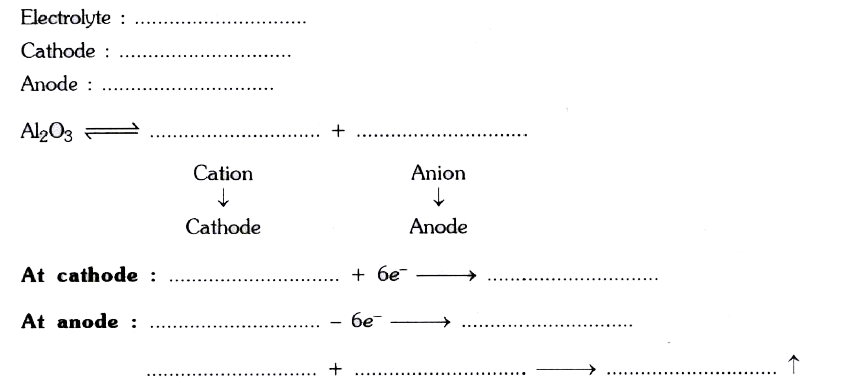Amphoteric nature of aluminium is employed in which of the following process for extraction of aluminium ?
Baeyer's process
Hall's process
Serpeck's process
Dow's process
The correct Answer is:A, B
To answer the question regarding the amphoteric nature of aluminum and its application in the extraction process, we will analyze the relevant processes step by step.
1. Understanding Amphoteric Nature:
- Amphoteric substances can react with both acids and bases. Aluminum hydroxide (Al(OH)₃) is a classic example of an amphoteric compound, as it can react with both acidic and basic solutions.
2. Extraction Processes:
- The primary methods for extracting aluminum from its ores include the Bayer process and Hall-Héroult process. The Bayer process is particularly relevant here, as it utilizes the amphoteric nature of aluminum.
3. Bayer Process Overview:
- In the Bayer process, bauxite ore (which contains aluminum oxide) is first crushed and then treated with a concentrated sodium hydroxide (NaOH) solution at high temperatures (around 150°C). This step is known as leaching.
4. Leaching Process:
- During leaching, aluminum oxide reacts with sodium hydroxide to form sodium aluminate (NaAlO₂), while impurities such as iron oxides (Fe₂O₃) and silica (SiO₂) remain undissolved. The reaction can be represented as:
Al2O3+2NaOH+3H2O→2NaAl(OH)4
5. Filtration:
- After leaching, the mixture is filtered. The sodium aluminate solution (filtrate) is separated from the solid impurities (residue).
6. Precipitation of Aluminum Hydroxide:
- The sodium aluminate solution is then diluted with water, and aluminum hydroxide (Al(OH)₃) precipitates out. This is where the amphoteric nature of aluminum plays a crucial role. The precipitation can be influenced by pH:
- In basic conditions, Al(OH)₄⁻ ions are formed.
- In acidic conditions, Al(OH)₃ can dissolve back into aluminum ions.
7. Calcination:
- The precipitated aluminum hydroxide (Al(OH)₃) is then heated (calcined) at high temperatures (around 1100°C) to produce aluminum oxide (Al₂O₃), which is the final product before aluminum metal is extracted through electrolysis.
8. Conclusion:
- The amphoteric nature of aluminum is effectively utilized in the Bayer process for the extraction of aluminum from bauxite ore. This process demonstrates how aluminum hydroxide can react with both acids and bases, facilitating the extraction of aluminum.
- Amphoteric substances can react with both acids and bases. Aluminum hydroxide (Al(OH)₃) is a classic example of an amphoteric compound, as it can react with both acidic and basic solutions.
- The primary methods for extracting aluminum from its ores include the Bayer process and Hall-Héroult process. The Bayer process is particularly relevant here, as it utilizes the amphoteric nature of aluminum.
- In the Bayer process, bauxite ore (which contains aluminum oxide) is first crushed and then treated with a concentrated sodium hydroxide (NaOH) solution at high temperatures (around 150°C). This step is known as leaching.
- During leaching, aluminum oxide reacts with sodium hydroxide to form sodium aluminate (NaAlO₂), while impurities such as iron oxides (Fe₂O₃) and silica (SiO₂) remain undissolved. The reaction can be represented as:
Al2O3+2NaOH+3H2O→2NaAl(OH)4
- After leaching, the mixture is filtered. The sodium aluminate solution (filtrate) is separated from the solid impurities (residue).
- The sodium aluminate solution is then diluted with water, and aluminum hydroxide (Al(OH)₃) precipitates out. This is where the amphoteric nature of aluminum plays a crucial role. The precipitation can be influenced by pH:
- In basic conditions, Al(OH)₄⁻ ions are formed.
- In acidic conditions, Al(OH)₃ can dissolve back into aluminum ions.
- The precipitated aluminum hydroxide (Al(OH)₃) is then heated (calcined) at high temperatures (around 1100°C) to produce aluminum oxide (Al₂O₃), which is the final product before aluminum metal is extracted through electrolysis.
- The amphoteric nature of aluminum is effectively utilized in the Bayer process for the extraction of aluminum from bauxite ore. This process demonstrates how aluminum hydroxide can react with both acids and bases, facilitating the extraction of aluminum.
Topper's Solved these Questions
- METALLURGYBOOK - VK JAISWAL ENGLISHCHAPTER - METALLURGYEXERCISE - MATCH THE COLUMN
20 Videos
- METALLURGYBOOK - VK JAISWAL ENGLISHCHAPTER - METALLURGYEXERCISE - ASSERTION-REASON TYPE QUESTIONS
29 Videos
- METALLURGYBOOK - VK JAISWAL ENGLISHCHAPTER - METALLURGYEXERCISE - Level 3 (Passive 7)
8 Videos
- ENVIRONMENTAL CHEMISTRYBOOK - VK JAISWAL ENGLISHCHAPTER - ENVIRONMENTAL CHEMISTRYEXERCISE - ASSERTION-REASON TYPE QUESTIONS
14 Videos
- p-BLOCK ELEMENTSBOOK - VK JAISWAL ENGLISHCHAPTER - p-BLOCK ELEMENTSEXERCISE - SUBJECTIVE PROBLEMS
35 Videos
Similar Questions
Knowledge Check
Which of the following is not the ore of aluminium?
ABauxiteBCryoliteCKerniteDCorundum
Which of the following is/are the compound of aluminium?
View SolutionWhich one of the following is not an ore of aluminium ?
View SolutionWhich one of the following is not an ore of aluminium ?
View SolutionComplete the following table with respect to extraction of aluminium :

View SolutionWhich of the following does not contain aluminium?
View SolutionWhich of the following minerals contain aluminium ?
View SolutionWhich of the following is amphoteric in nature?
View Solution
